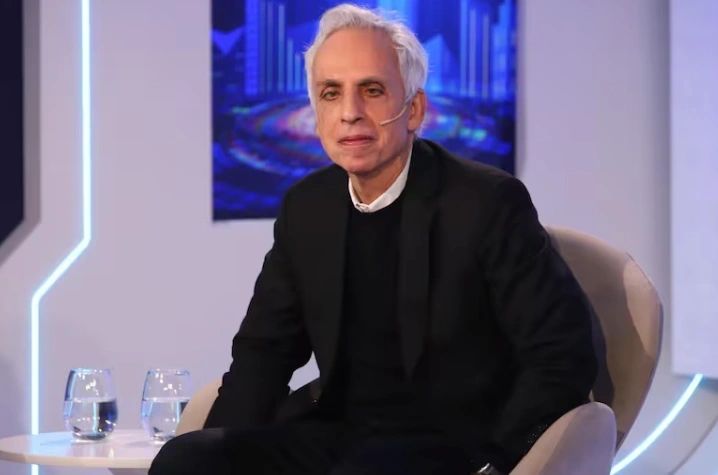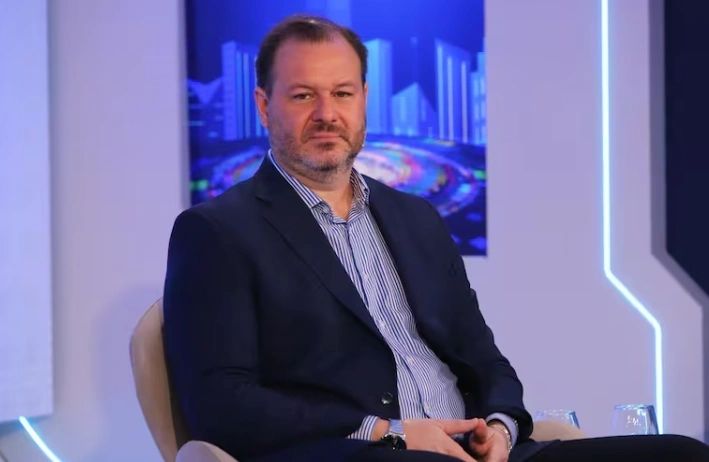BuySellBA
Administrator
The changes in construction methods that are coming to real estate and the challenge of mortgage lending - La Nacion Propiedades

Source:

 www.lanacion.com.ar
www.lanacion.com.ar
July 18, 2025
At the LA NACION meeting, Issel Kiperszmid (DYPSA), Daniel Mintzer (G&D Developers), Jeremías González Toledo (Inarch) and Lucas Salvatore (IDERO) shared their market diagnosis and the keys to the future.
By Iñaki Zurueta

The developers were the protagonists of a unique morningFabian Malavolta - LA NACION
At the tenth edition of the Real Estate Summit organized by LA NACION , four leading developers in the Argentine real estate sector shared their market assessments and possible paths to address the historic housing shortage. The panel, moderated by LA NACION journalist Carla Quiroga, brought together Issel Kiperszmid (CEO of DYPSA Group and founder and vice president of the Chamber of Urban Developers), Daniel Mintzer (director of G&D Developers), Jeremías González Toledo (Commercial Director of Inarch), and Lucas Salvatore (director of IDERO, Real Steel, and Grupo Salvatore).
“One of my sons is joining the company, and I always tell people that when I was his age and just starting out in this business, I had the shock of the Rodrigazo. From then on, they ask me: 'What are you, a developer?' And I tell them no, I'm a crisologist; I work with overcoming crises ,” laughed Issel Kiperszmid, CEO of DYPSA Group , explaining how crises shape the business.

From left to right: Jeremías González Toledo (Commercial Director of Inarch), Carla Quiroga (La Nación) and Issel Kiperszmid (CEO of DYPSA Group)Fabian Malavolta
Along the same lines, Lucas Salvatore, director of IDERO and Real Steel , noted: “ As the economy normalizes, the country normalizes . If they give you energy, no one insulates their walls, because it's cheaper not to. If the only way to finance a real estate project was through a five-year cost-based trust, no one is going to build quickly; they build slowly. One is a consequence of the other.”
Asked about the conditions that must be met to reverse the historic deficit of three million households , Kiperszmid was clear: “It will be a relatively long process because many variables must align. First of all, without a doubt, the macroeconomics, a necessary but not sufficient condition. Furthermore, for a sector with repayment capacity, the other condition is credit at relatively reasonable rates, and for that, there must be a capital market where banks can obtain financing, which is not the case today.”
Along those lines, Daniel Mintzer, director of G&D Developers , said: “Credit rates are a little high, but that's because there's little credit. There's little loanable money. There's much more demand from people who want to take out credit than from people who can put up money to generate it . It's a matter of building trust.”

Daniel Mintzer, director of G&D Developers. Fabian Malavolta
Despite the restrictive context, Mintzer sees signs of improvement: “Last year, people couldn't buy with what they earned; they bought with what they already had. Instead, today, they buy with what they already have and a little with what they earn (in some segments).” He added: “We still have a lot to do, but at least having some credit and slightly higher dollar values for what people earn makes us a little more accessible. We can look at the glass in two ways: either what's missing—which is always a lot—or what's already been done .”
Regarding the possibility of enabling dollar loans, in line with recent statements by Economy Minister Luis Caputo, Kiperszmid was categorical: “A dollar credit market is absolutely necessary . ” Mintzer offered a more nuanced view: “In my opinion, a dollar credit market isn't the best option, but it's much better if there are people willing to invest dollars to receive dollars at a certain rate (which can't be achieved with the peso). As long as the dollar and the peso move differently and people earn in pesos, it's better to provide credit in the local currency, but it's much better to have dollar credit than no credit at all .”
In addition, Kiperszmid proposed three measures that he considers key to unlocking the dynamics of the sector : “First of all, it must dispose of the shares held by the FGS (Sustainability Guarantee Fund), sell those shares that aren't earning anything, and apply them to a fund that allows banks to discharge their mortgages. The second condition is to lower taxes on the sector—currently, according to the construction model, the tax burden is between 46% and 52%, if you add up the entire chain of taxes, meaning that if the construction cost of a property is US$1,500, about US$750 is tax. The third condition required for this to happen is to help us developers be more dynamic in construction. What depends on the State is the entire issue of approvals, interference, everything that isn't fiscal but also weighs heavily.”

Issel Kiperszmid (CEO of DYPSA Group)Fabian Malavolta
Among the strategic decisions that can define a business model, Mintzer highlighted that his company is targeting an underserved segment : “We believe that the sector that buys an apartment for between US$50,000 and US$100,000 is very underserved, and we think it's an important market opportunity.” As an example, he cited the Moca 2 project : “We are finishing the project in what used to be the Bagley factory, which was the police parking lot across from the highway in Barracas. We started selling there for US$1,500 per square meter, and today we're at US$2,300—US$2,400 and rising.”

Carla Quiroga (La Nación) with Issel Kiperszmid (CEO of DYPSA Group) and Daniel Mintzer (director of G&D Developers)Fabian Malavolta
Regarding his choice to intervene in non-traditional areas, the director of G&D Developers explained: “We're a company that doesn't focus solely on location , but on creating an environment. We want to create a place where no one thinks a building could possibly exist there, and we buy with a metro, with a swap, with whatever, and you create something remarkable for the city.”
From IDERO and Real Steel, Lucas Salvatore offered an aligned vision: “ We build by integrating industry and architecture , which is our focus, and that makes sense in a more normal country. As we think the money for construction will be there, whether through loans or whatever, building more efficiently and faster is unquestionable; it can be done anywhere in the world.”
“Today, at our Moreno plant, we're able to build like they do in many parts of the world, which is on an assembly line where the raw materials come in through one door and the finished house comes out 200 meters later . That assembly-line home costs—all things being equal in finishes and other aspects— about US$1,500 for a traditional one versus about US$1,000 for a modular one , a very significant difference when comparing similar quality.”

Lucas Salvatore, director of IDERO, Real Steel and Grupo SalvatoreFabian Malavolta
For Salvatore, " the situation is ripe for industrialized systems to take on a much greater role , whether made of steel or concrete, but with a different logic. That in 2025 the construction method will be to stick one brick next to another sounds quite strange and I don't see the logic behind it."
The company's current focus is on Añelo , the productive heart of Vaca Muerta. " We built four buildings there and are currently manufacturing and constructing two more. We built the last ones entirely in Moreno . The last one, for example, called Añelo Central, where we are solely a construction company, was assembled in 28 consecutive days and was the first six-story modular building in Argentina."
Elaborating on the profitability of this scheme, he added: "In Añelo, we're getting a 12% to 15% return on investment (the amount of the apartment purchased versus the rental income) and a 10% to 12% return on the completed apartment. Investors have the option of getting in at the riskiest moment and exiting once it's finished within a year, with a 20% markup ."
Today, they're involved in two major projects: " We're working on our own project, the Añelo District , with ground-floor buildings plus two floors, where we have the potential to add 1,200 beds. It's a US$60 million investment, all in stages. We're also involved in the Añelo Central project, which belongs to another developer—where we're the construction partner—and is a US$70 million investment with six-story buildings." Both initiatives are geared toward the same sector, albeit with different profiles.
Kiperszmid, meanwhile, explained that DYPSA is also moving toward industrialized models, but with concrete . “In a factory, in a controlled environment, you produce all the panels for a house or a five-story building, where each panel has its own ID, comes with its installations and everything, and you take it and assemble it on-site,” he noted. “We're starting with one of our projects in Ezeiza, where we already have the first sample units. Production costs are down approximately 15%, and our goal is to reduce them by 25%, but fundamentally, it significantly reduces lead times.”

Jeremías González Toledo, commercial director of InarchFabian Malavolta
The group he leads is developing six residential buildings, each measuring between 5,000 and 7,000 square meters, distributed in key locations throughout the city: three in Núñez, two in Palermo Hollywood, and one in Monserrat . In addition to these projects, two new commercial initiatives are about to begin, one in Canning and another in Buenos Aires .
However, they also have one of their most ambitious projects, ViaViva , a project that redefines the urban layout of the Bajo Viaducto Mitre neighborhood . "We are awarded the land concession for the Bajo Viaducto Mitre neighborhood. The Chinatown area is already fully established, with 100 stores, and at the end of this year we will open the Libertador neighborhood. Unlike Chinatown, which is more gastronomic and on the go, Libertador will have a higher-priced profile, with car dealerships and a gastronomic offering," he explained.
The project continues to expand with a third phase underway . "Finally, we'll soon begin construction on the Hippodrome, which will now be more of a 24/7 facility. We're talking an investment of around US$60 million."
González Toledo also highlighted Inarch's strategy of integrating multiple business units under a single structure , from architecture and construction to cleaning, marketing, and trusts, which improves the traceability and efficiency of the entire process. Its model focuses on internal professionalization and a coordinated growth strategy that focuses on both the product and the urban experience.
“The China issue requires fine-tuning. It's already having significant effects; for example, aluminum prices fell by almost 30%,” Kiperszmid noted. He added: “ This creates opportunities where several developers are joining forces to import specific products . On the other hand, more importers are emerging and are skipping steps that previously existed, which improves costs.”
Mintzer, on the other hand, focused on the need for local support: “ We need to buy everything with a guarantee, so I prefer to pay a little more but have a phone number to call when people have a problem or need something .” He warned: “Today, a building is 50% labor, and the other 50% you can bring in from China can be between 5% and 10%, so that percentage isn't worth the risk of not having the guarantee.”
From Inarch, González Toledo agreed with this cautious view: “There are two sides to the China issue. On the one hand, you have to be responsible; there are the people who do business with the imports, and then, as a developer, the real impact on costs is relatively low, and the risk one assumes when importing—especially finishes—is significant .” In this sense, he emphasized the value of strategic ties: “It's essential to rely on strategic partners, also known as suppliers, who are someone who not only supports you in the project but also supports you afterward with the issue of guarantees.”
www.buysellba.com
Source:
Los cambios en la forma de construir que llegan al real estate y el desafío del crédito hipotecario
En el encuentro de LA NACION, Issel Kiperszmid (DYPSA), Daniel Mintzer (G&D Developers), Jeremías González Toledo (Inarch) y Lucas Salvatore (IDERO) compartieron su diagnóstico del mercado y las claves a futuro
July 18, 2025
At the LA NACION meeting, Issel Kiperszmid (DYPSA), Daniel Mintzer (G&D Developers), Jeremías González Toledo (Inarch) and Lucas Salvatore (IDERO) shared their market diagnosis and the keys to the future.
By Iñaki Zurueta

The developers were the protagonists of a unique morningFabian Malavolta - LA NACION
At the tenth edition of the Real Estate Summit organized by LA NACION , four leading developers in the Argentine real estate sector shared their market assessments and possible paths to address the historic housing shortage. The panel, moderated by LA NACION journalist Carla Quiroga, brought together Issel Kiperszmid (CEO of DYPSA Group and founder and vice president of the Chamber of Urban Developers), Daniel Mintzer (director of G&D Developers), Jeremías González Toledo (Commercial Director of Inarch), and Lucas Salvatore (director of IDERO, Real Steel, and Grupo Salvatore).
A neat macro: just the starting point
The specialists began by analyzing the current situation in the country and how a more stable macroeconomy enables the possibility of projecting into the future and bringing a degree of predictability to the sector. Although this is a necessary condition for reactivating the industry, growing, and reducing the housing shortage, it is far from sufficient on its own .“One of my sons is joining the company, and I always tell people that when I was his age and just starting out in this business, I had the shock of the Rodrigazo. From then on, they ask me: 'What are you, a developer?' And I tell them no, I'm a crisologist; I work with overcoming crises ,” laughed Issel Kiperszmid, CEO of DYPSA Group , explaining how crises shape the business.

From left to right: Jeremías González Toledo (Commercial Director of Inarch), Carla Quiroga (La Nación) and Issel Kiperszmid (CEO of DYPSA Group)Fabian Malavolta
Along the same lines, Lucas Salvatore, director of IDERO and Real Steel , noted: “ As the economy normalizes, the country normalizes . If they give you energy, no one insulates their walls, because it's cheaper not to. If the only way to finance a real estate project was through a five-year cost-based trust, no one is going to build quickly; they build slowly. One is a consequence of the other.”
Asked about the conditions that must be met to reverse the historic deficit of three million households , Kiperszmid was clear: “It will be a relatively long process because many variables must align. First of all, without a doubt, the macroeconomics, a necessary but not sufficient condition. Furthermore, for a sector with repayment capacity, the other condition is credit at relatively reasonable rates, and for that, there must be a capital market where banks can obtain financing, which is not the case today.”
Along those lines, Daniel Mintzer, director of G&D Developers , said: “Credit rates are a little high, but that's because there's little credit. There's little loanable money. There's much more demand from people who want to take out credit than from people who can put up money to generate it . It's a matter of building trust.”

Daniel Mintzer, director of G&D Developers. Fabian Malavolta
Despite the restrictive context, Mintzer sees signs of improvement: “Last year, people couldn't buy with what they earned; they bought with what they already had. Instead, today, they buy with what they already have and a little with what they earn (in some segments).” He added: “We still have a lot to do, but at least having some credit and slightly higher dollar values for what people earn makes us a little more accessible. We can look at the glass in two ways: either what's missing—which is always a lot—or what's already been done .”
Regarding the possibility of enabling dollar loans, in line with recent statements by Economy Minister Luis Caputo, Kiperszmid was categorical: “A dollar credit market is absolutely necessary . ” Mintzer offered a more nuanced view: “In my opinion, a dollar credit market isn't the best option, but it's much better if there are people willing to invest dollars to receive dollars at a certain rate (which can't be achieved with the peso). As long as the dollar and the peso move differently and people earn in pesos, it's better to provide credit in the local currency, but it's much better to have dollar credit than no credit at all .”
In addition, Kiperszmid proposed three measures that he considers key to unlocking the dynamics of the sector : “First of all, it must dispose of the shares held by the FGS (Sustainability Guarantee Fund), sell those shares that aren't earning anything, and apply them to a fund that allows banks to discharge their mortgages. The second condition is to lower taxes on the sector—currently, according to the construction model, the tax burden is between 46% and 52%, if you add up the entire chain of taxes, meaning that if the construction cost of a property is US$1,500, about US$750 is tax. The third condition required for this to happen is to help us developers be more dynamic in construction. What depends on the State is the entire issue of approvals, interference, everything that isn't fiscal but also weighs heavily.”

Issel Kiperszmid (CEO of DYPSA Group)Fabian Malavolta
How to innovate
“I entered Canning on horseback ,” Kiperszmid recalled about the moment he discovered the neighborhood and decided to invest in its development. “At that time, the Panamericana Highway—the Autopistas del Sol highway—was just starting, so a lot of projects started happening in the area along the Panamericana axis. We were in Puerto Madero, so I said, 'I'm late getting here,' so I grabbed a map of Greater Buenos Aires and thought about where I could find an undeveloped green zone with future access, that was relatively equidistant from the center of what used to be the Panamericana, and we went to look.” That's how he landed on a 242-home development that he and another group built. “ Later, we built a 306-home development and added a school, which changed the dynamic ,” he summarized.Among the strategic decisions that can define a business model, Mintzer highlighted that his company is targeting an underserved segment : “We believe that the sector that buys an apartment for between US$50,000 and US$100,000 is very underserved, and we think it's an important market opportunity.” As an example, he cited the Moca 2 project : “We are finishing the project in what used to be the Bagley factory, which was the police parking lot across from the highway in Barracas. We started selling there for US$1,500 per square meter, and today we're at US$2,300—US$2,400 and rising.”

Carla Quiroga (La Nación) with Issel Kiperszmid (CEO of DYPSA Group) and Daniel Mintzer (director of G&D Developers)Fabian Malavolta
Regarding his choice to intervene in non-traditional areas, the director of G&D Developers explained: “We're a company that doesn't focus solely on location , but on creating an environment. We want to create a place where no one thinks a building could possibly exist there, and we buy with a metro, with a swap, with whatever, and you create something remarkable for the city.”
From IDERO and Real Steel, Lucas Salvatore offered an aligned vision: “ We build by integrating industry and architecture , which is our focus, and that makes sense in a more normal country. As we think the money for construction will be there, whether through loans or whatever, building more efficiently and faster is unquestionable; it can be done anywhere in the world.”
“Today, at our Moreno plant, we're able to build like they do in many parts of the world, which is on an assembly line where the raw materials come in through one door and the finished house comes out 200 meters later . That assembly-line home costs—all things being equal in finishes and other aspects— about US$1,500 for a traditional one versus about US$1,000 for a modular one , a very significant difference when comparing similar quality.”

Lucas Salvatore, director of IDERO, Real Steel and Grupo SalvatoreFabian Malavolta
For Salvatore, " the situation is ripe for industrialized systems to take on a much greater role , whether made of steel or concrete, but with a different logic. That in 2025 the construction method will be to stick one brick next to another sounds quite strange and I don't see the logic behind it."
The company's current focus is on Añelo , the productive heart of Vaca Muerta. " We built four buildings there and are currently manufacturing and constructing two more. We built the last ones entirely in Moreno . The last one, for example, called Añelo Central, where we are solely a construction company, was assembled in 28 consecutive days and was the first six-story modular building in Argentina."
Elaborating on the profitability of this scheme, he added: "In Añelo, we're getting a 12% to 15% return on investment (the amount of the apartment purchased versus the rental income) and a 10% to 12% return on the completed apartment. Investors have the option of getting in at the riskiest moment and exiting once it's finished within a year, with a 20% markup ."
Today, they're involved in two major projects: " We're working on our own project, the Añelo District , with ground-floor buildings plus two floors, where we have the potential to add 1,200 beds. It's a US$60 million investment, all in stages. We're also involved in the Añelo Central project, which belongs to another developer—where we're the construction partner—and is a US$70 million investment with six-story buildings." Both initiatives are geared toward the same sector, albeit with different profiles.
Kiperszmid, meanwhile, explained that DYPSA is also moving toward industrialized models, but with concrete . “In a factory, in a controlled environment, you produce all the panels for a house or a five-story building, where each panel has its own ID, comes with its installations and everything, and you take it and assemble it on-site,” he noted. “We're starting with one of our projects in Ezeiza, where we already have the first sample units. Production costs are down approximately 15%, and our goal is to reduce them by 25%, but fundamentally, it significantly reduces lead times.”
New opportunities and new consumers
“There's a change in consumer habits, and that's important because the way we communicate and sell real estate developments still needs to adapt a little more to how new generations consume,” said González Toledo of Inarch . “Today, there are a ton of tools we can use to reach people and give them a glimpse into the project that will be delivered in five years, and throughout the process, make people feel, in some way, what they're buying.”
Jeremías González Toledo, commercial director of InarchFabian Malavolta
The group he leads is developing six residential buildings, each measuring between 5,000 and 7,000 square meters, distributed in key locations throughout the city: three in Núñez, two in Palermo Hollywood, and one in Monserrat . In addition to these projects, two new commercial initiatives are about to begin, one in Canning and another in Buenos Aires .
However, they also have one of their most ambitious projects, ViaViva , a project that redefines the urban layout of the Bajo Viaducto Mitre neighborhood . "We are awarded the land concession for the Bajo Viaducto Mitre neighborhood. The Chinatown area is already fully established, with 100 stores, and at the end of this year we will open the Libertador neighborhood. Unlike Chinatown, which is more gastronomic and on the go, Libertador will have a higher-priced profile, with car dealerships and a gastronomic offering," he explained.
The project continues to expand with a third phase underway . "Finally, we'll soon begin construction on the Hippodrome, which will now be more of a 24/7 facility. We're talking an investment of around US$60 million."
González Toledo also highlighted Inarch's strategy of integrating multiple business units under a single structure , from architecture and construction to cleaning, marketing, and trusts, which improves the traceability and efficiency of the entire process. Its model focuses on internal professionalization and a coordinated growth strategy that focuses on both the product and the urban experience.
China's influence in the sector
Regarding the impact of the Asian giant on the construction value chain, developers' positions varied, although they shared one common denominator: the need to carefully evaluate costs, guarantees, and associated risks.“The China issue requires fine-tuning. It's already having significant effects; for example, aluminum prices fell by almost 30%,” Kiperszmid noted. He added: “ This creates opportunities where several developers are joining forces to import specific products . On the other hand, more importers are emerging and are skipping steps that previously existed, which improves costs.”
Mintzer, on the other hand, focused on the need for local support: “ We need to buy everything with a guarantee, so I prefer to pay a little more but have a phone number to call when people have a problem or need something .” He warned: “Today, a building is 50% labor, and the other 50% you can bring in from China can be between 5% and 10%, so that percentage isn't worth the risk of not having the guarantee.”
From Inarch, González Toledo agreed with this cautious view: “There are two sides to the China issue. On the one hand, you have to be responsible; there are the people who do business with the imports, and then, as a developer, the real impact on costs is relatively low, and the risk one assumes when importing—especially finishes—is significant .” In this sense, he emphasized the value of strategic ties: “It's essential to rely on strategic partners, also known as suppliers, who are someone who not only supports you in the project but also supports you afterward with the issue of guarantees.”
www.buysellba.com

